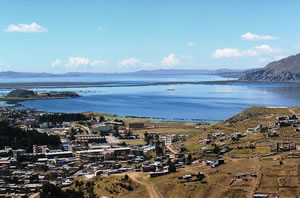Lake Titicaca is the largest lake in South America and one of the highest and longest lakes in the world.
Lake Titicaca lies on the border of Peru and Bolivia.
It is 3,800m (12,500ft) high and 177km (110mi) long.
Legend says that Lake Titicaca is the birthplace of the Inca civilization.
The lake lies on the Altiplano, or "high plain" between parallel ranges of the snowcapped Andes Mountains.
 Much of Lake Titicaca is contained in a steep-sided basin with a maximum depth of 281m (922ft) and an average depth of 107m (351ft).
Much of Lake Titicaca is contained in a steep-sided basin with a maximum depth of 281m (922ft) and an average depth of 107m (351ft).
In the course of a year, the water level fluctuates between 50cm (1.6ft) and lm (3.3ft). From December to March, when heavy rains sweep across the region, the level rises. During the rest of the year, the level falls.
From year to year, the waters of the lake may rise and fall by a total of 5m (16ft).
Evidence from the surrounding terrain suggests that, after the last ice age, around 10,000 years ago, the lake's shoreline was 45m (150ft) higher than it is today.
A little over half of the lake's annual water input comes from rainfall. The rest comes from the many rivers and streams from the surrounding plain, a drainage area more than seven times the size of the lake.
Ninety percent of the lake's water evaporates because of the high altitude, strong sun and frequent winds, leaving behind salts and minerals.
The only outlet, the Desaguadero River, drains less than one tenth Titicaca's water southward to Lake Poopó, which has no outlet. Only evaporation stabilizes its level. Its waters are 20 times as salty as those of Titicaca.
The average temperature of the air around Lake Titicaca is 11°C (51°F) although extremes may fluctuate considerably around this figure.
This means that the average water temperature of the lake is also about 11°C (51°F). This is relatively cold for a lake that is so close to the equator. The lake's high altitude is the reason for its lower temperature.